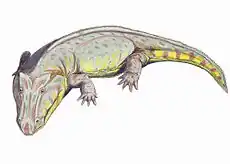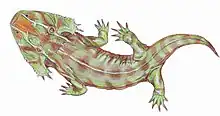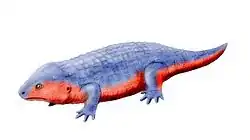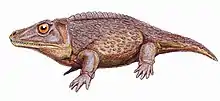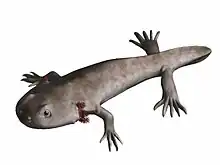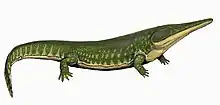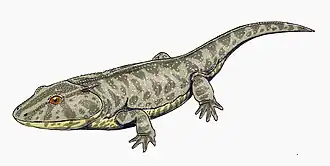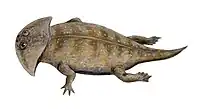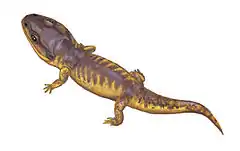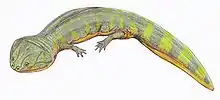| Tupilakosauridae Temporal range: Early Permian - Early Triassic, | |
|---|---|
 | |
| Tupilakosaurus | |
| Scientific classification | |
| Domain: | Eukaryota |
| Kingdom: | Animalia |
| Phylum: | Chordata |
| Class: | Amphibia |
| Order: | †Temnospondyli |
| Suborder: | †Dvinosauria |
| Superfamily: | †Dvinosauroidea |
| Family: | †Tupilakosauridae Kuhn, 1960 |
| Genera | |
Tupilakosauridae is an extinct family of dvinosaurian temnospondyls. It contains the genera Slaugenhopia, Thabanchuia, Tupilakosaurus, and possibly Kourerpeton.[1] Tupilakosaurs are known from Texas, Greenland, Russia, and France.[1][2] The earliest tupilakosaur, Slaugenhopia, is Early Permian in age while the latest known tupilakosaurs are Early Triassic in age. Derived tupilakosaurs possess embolomerous centra in their vertebrae, which are diplospondylous.[2] They also have a deep notch in the pterygoid bone of the palate.[1] Tupilakosaurs were aquatic, and used an undulatory mode of swimming much like that of eels.[2]
References
- 1 2 3 Milner, A. R.; Sequeira, S. E. K. (2004). "Slaugenhopia texensis (Amphibia: Temnospondyli) from the Permian of Texas is a primitive tupilakosaurid". Journal of Vertebrate Paleontology. 24 (2): 320–325. doi:10.1671/1974.
- 1 2 3 Werneburg, R.; Steyer, J. S.; Sommer, G.; Gand, G.; Schneider, J. W.; Vianey-Liaud, M. (2007). "The earliest tupilakosaurid amphibian with diplospondylous vertebrae from the Late Permian of southern France". Journal of Vertebrate Paleontology. 27 (1): 26–30. doi:10.1671/0272-4634(2007)27[26:TETAWD]2.0.CO;2.
External links
This article is issued from Wikipedia. The text is licensed under Creative Commons - Attribution - Sharealike. Additional terms may apply for the media files.
